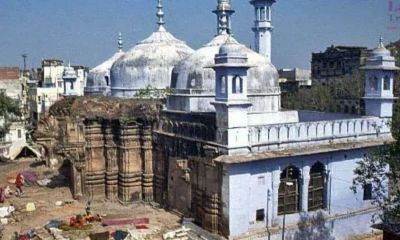Edited by Deepali Verma
Recently, in the legal battle surrounding Varanasi’s Gyanvapi Masjid, a district court permitted the members of a family of priests to pray in one of the cellars in the mosque complex. This cellar known as Vyasji ka Tehkhana was unsealed on the night of January 31 and a puja was held around 3 am.
A Cellar Temple
Built in the 17th Century, the Gyanvapi mosque has a total of four cellars and the ‘Vyas ji ka Tehkhana’ is one of them. Present in the southern area of the mosque’s barricaded complex, it is right opposite to a statue of Nandi bull in the adjoining Kashi Vishwanath temple premises. The cellar has a height of 7 feet with an area of 40 square feet. The petitioner, Shailendra Pathak Vyas, remarked that there are idols there that were worshipped prior to sealing of the cellar in 1993. However, the Muslim side denied this in the court and argued that the petitioner had not placed any evidence that prayers were held there while also stating that there is no idol in the cellar.
The petitioner’s counsel counter argued stating that the Vyas family had been worshipping inside the cellar for close to two centuries. The family, as per the counsel, got control of the cellar even during British rule. The petitioner’s counsel said that in the aftermath of riots in 1819, the British administration devised a balancing plan and transferred control of some parts of Gyanvapi mosque to Hindus. The Vyas family, which lives near the temple, had then started praying in the cellar.
As per the petition, the members of the family continued to perform puja in the cellar even after Independence. Hence, Vyas ji ka Tehkhana, meaning Vyas ji’s cellar is derived from the family name. Before the sealing of the cellar in 1993, Somnath Vyas used to conduct prayers there. The petitioner, Shailendra Pathak Vyas, on whose petition the verdict came yesterday, is the maternal grandson of Somnath Vyas.
Why Was Cellar Sealed
On December 6, 1992, the Babri Masjid was demolished in Ayodhya, where a Ram Temple has now come up after a landmark Supreme Court verdict. What followed was the imposition of the President’s Rule in the state and the next year, a government headed by Mulayam Singh Yadav took over. Citing law and order, Mr Yadav put a restriction on the prayers inside the cellar temple.
A 3 AM Puja
Around 3 am, hours after the court’s verdict, members of the Vyas family held puja inside the cellar after almost three decades. Jitendra Nath Vyas, a member of the family, in conversation with the news agency ANI revealed that five priests of Kashi Vishwanath temple, their family members and top district officials were present during the puja. There was deployment of heavy force near the mosque to prevent any flare-up.
What Comes Next
The mosque committee has said they will be contesting as yesterday’s ruling in the high court. Lawyer Akhlaq Ahmed told the media that the order has overlooked the Advocate Commissioner report of 2022, ASI’s report, and the decision of 1937, which was in their favour.
Advocate Merajuddin Siddiqui had laid accusations on the district officials of being hand-in-glove with the district magistrate. “The current scenario is to get political advantage. The same approach is being adopted, as was done in the Babri Masjid case. The Commissioner’s report as well as the ASI’s report earlier said that nothing was inside,” he said.
On the other hand, Hindu organisations have welcomed the verdict. “Today, a court in Kashi has given an extremely significant decision, filling the hearts of every Hindu with joy,” VHP working president Alok Kumar said. The BJP has refrained from making a comment on yesterday’s development, saying the matter is subjudice.

















